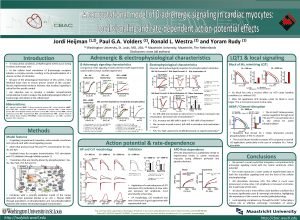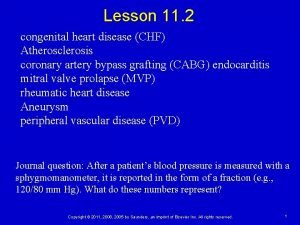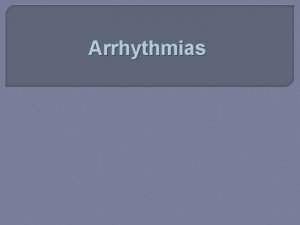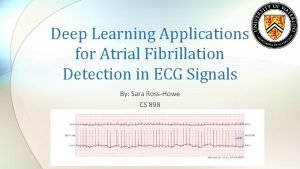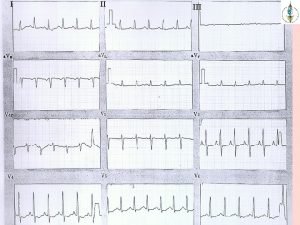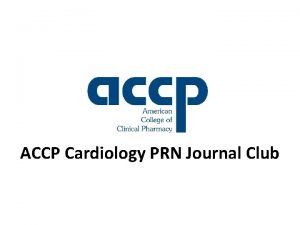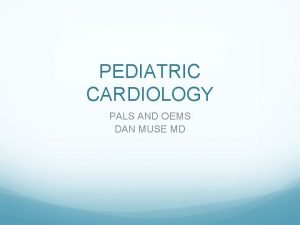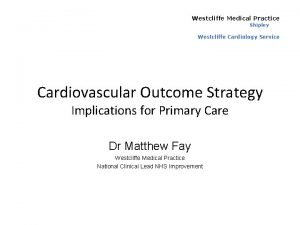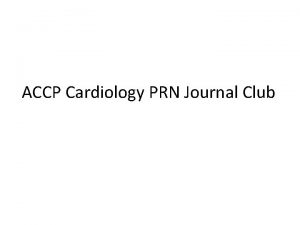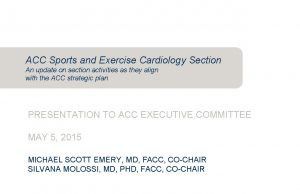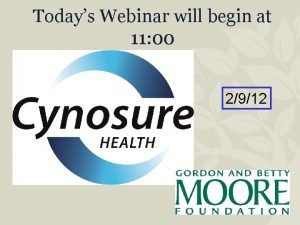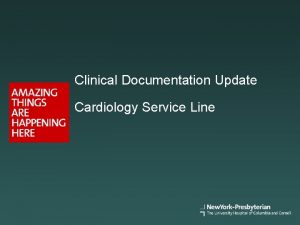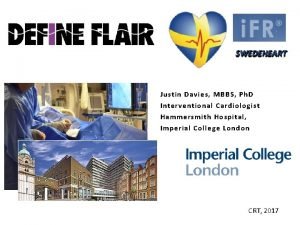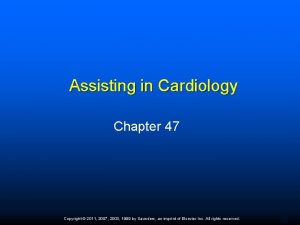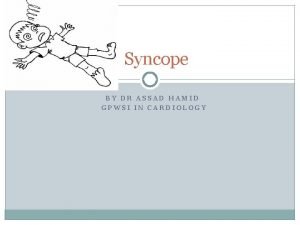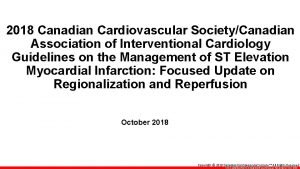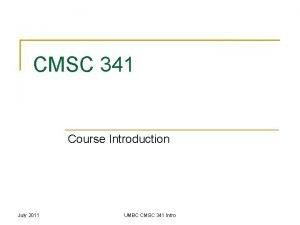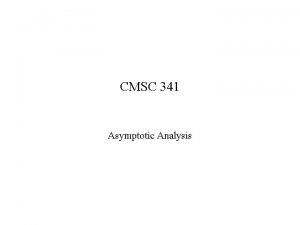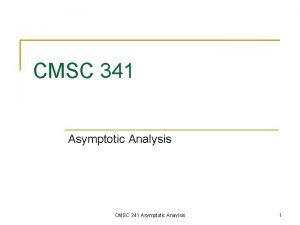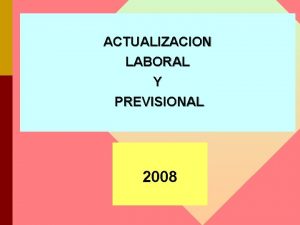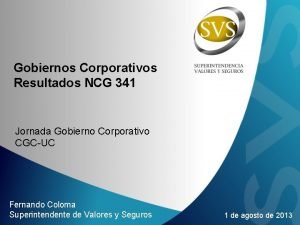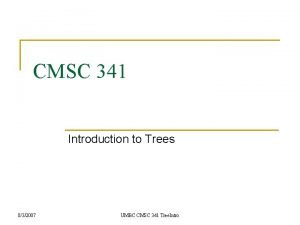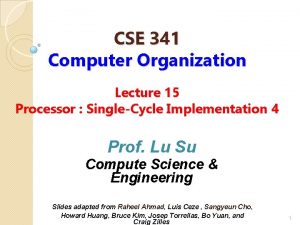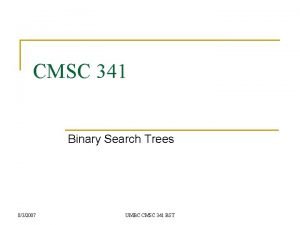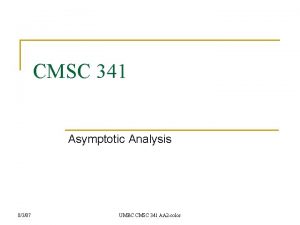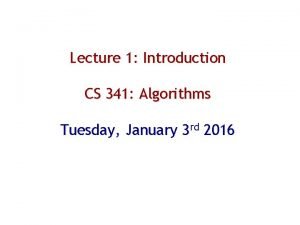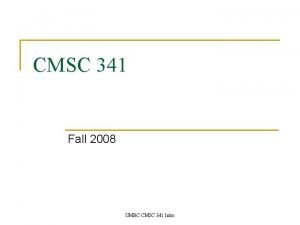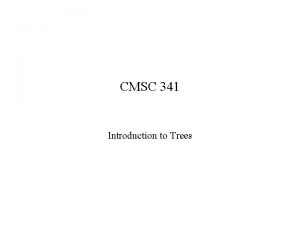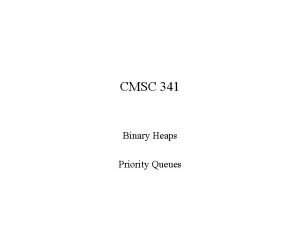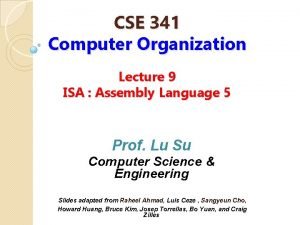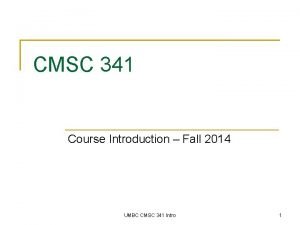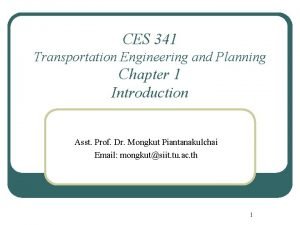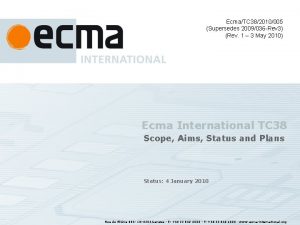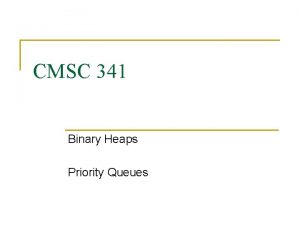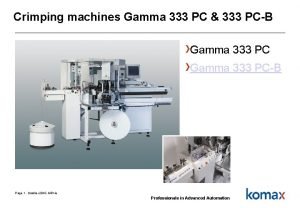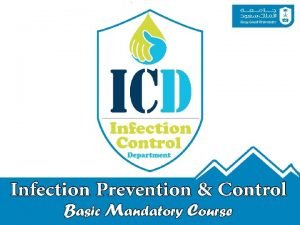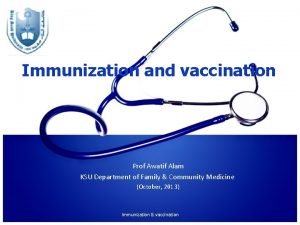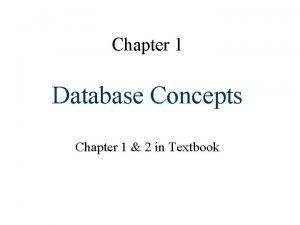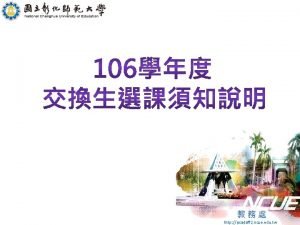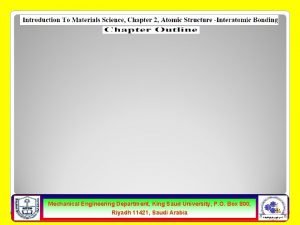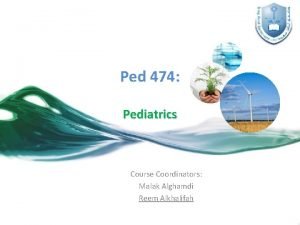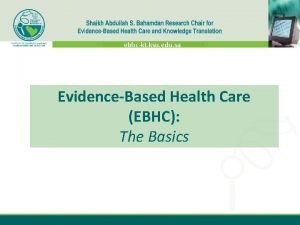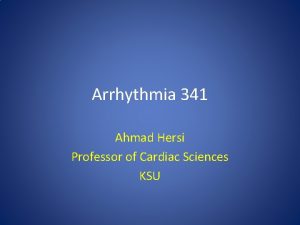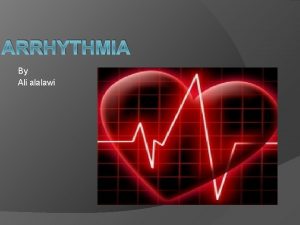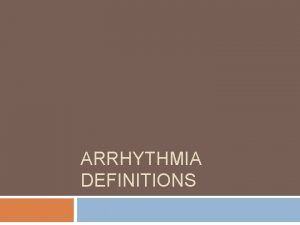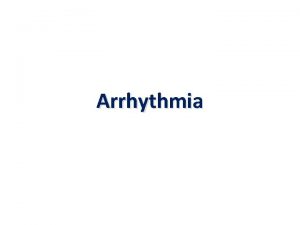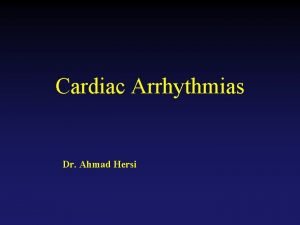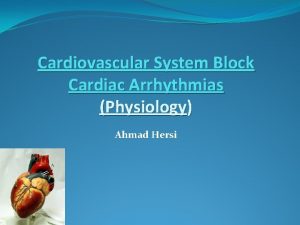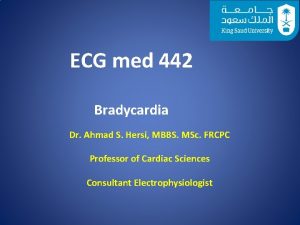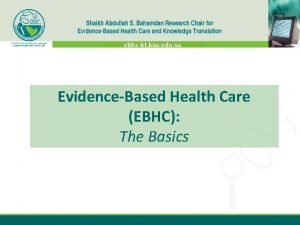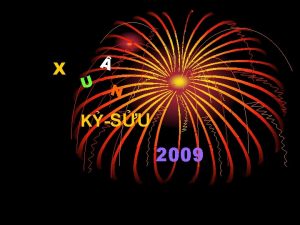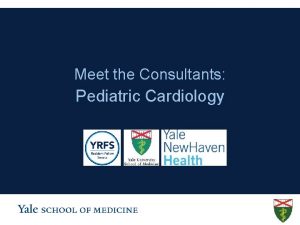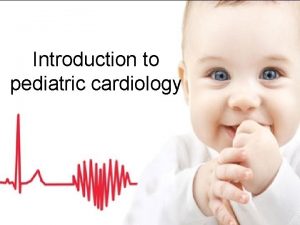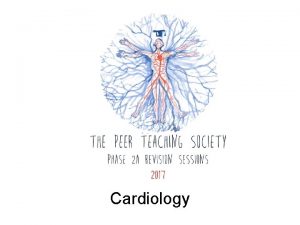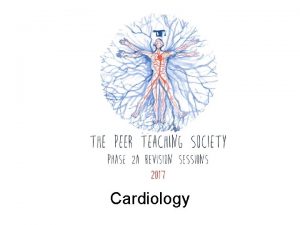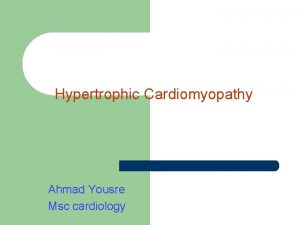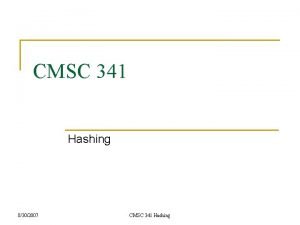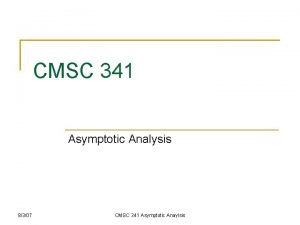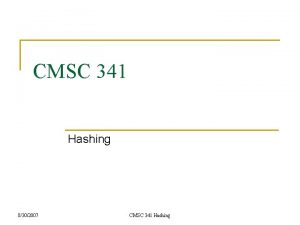Arrhythmia 341 Ahmad Hersi Professor of Cardiology KSU
























































- Slides: 56

Arrhythmia 341 Ahmad Hersi Professor of Cardiology KSU

Objectives • Identify mechanism of AF • Recognize EKG of AF • Discuss treatment options of AF • Identify other forms of Arrhythmia

Atrial fibrillation accounts for 1/3 of all patient discharges with arrhythmia as principal diagnosis. 6% PSVT 6% PVCs 18% Unspecified 4% Atrial Flutter 9% SSS 34% Atrial Fibrillation 8% Conduction Disease 10% VT 3% SCD 2% VF

Epidemiology • 2. 3 million people in North America • 4. 5 million in EU • In the 20 year AF admission have increased by 66%. • $ 15. 7 billion annually in EU • Estimated prevalence of AF is 0. 4% to 1% in the general pop. 8% in pt. >80 years

AF Prevalence in US Population

Pathophysiology of Atrial Fibrillation and associated Stroke

• Normal regulation of heart rate and rhythm Contraction is controlled by the sinoatrial (SA) node

Normal EKG


Normal heart rhythm is disrupted in AF • AF is characterized by: – Rapid (350– 600 beats/min) and irregular atrial rhythm – Reduced filling of the left and right ventricles • Conduction of most impulses from the atria to ventricles is blocked at the AV node • Contraction of the ventricles can be: – Irregular and rapid (110– 180 beats/min; tachycardia) – Irregular and slow (<50 beats/min; bradycardia) – Normal • Cardiac output can be reduced

AF begets AF • AF causes remodelling: – Electrical: shortening of refractory period – Structural: enlargement of atrial cavities • Many episodes of AF resolve spontaneously • Over time AF tends to become persistent or permanent. Wijffels MC et al. Circulation 195; 92: 1954– 68

Consequences of AF • Formation of blood clots (thrombosis) on the walls of the atria that can dislodge (embolize), leading to stroke and systemic embolism • Reduction in cardiac output can precipitate heart failure leading to: – Peripheral oedema – Pulmonary oedema

Diagnosis of Atrial Fibrillation

Atrial Fibrillation: Cardiac Causes • Hypertensive heart disease • Ischemic heart disease • Valvular heart disease – Rheumatic: mitral stenosis – Non-rheumatic: aortic stenosis, mitral regurgitation • Pericarditis • Cardiac tumors: atrial myxoma • Sick sinus syndrome • Cardiomyopathy – Hypertrophic – Idiopathic dilated (? cause vs. effect) • Post-coronary bypass surgery

Atrial Fibrillation: Non-Cardiac Causes • Pulmonary – COPD – Pneumonia – Pulmonary embolism • Metabolic – Thyroid disease: hyperthyroidism – Electrolyte disorder • Toxic: alcohol (‘holiday heart’ syndrome)

Diagnosis of AF • • Signs and symptoms Electrocardiography Transthoracic echocardiography Laboratory tests Holter monitoring Transoesophageal echocardiography Exercise testing Chest radiography

Heterogeneous clinical presentation of AF • With or without detectable heart disease • Episodic – Symptoms may be absent or intermittent – Up to 90% of episodes may not cause symptoms • Symptoms vary according to – Irregularity and rate of ventricular response – Functional status – AF duration – Patient factors – Co-morbidities Fuster V et al. Circulation 2006; 114: e 257–e 354; Page RL et al. Circulation 1994; 89: 224– 7

Signs and symptoms Cause Sign/symptom Irregular heart beat Irregularly irregular pulse Palpitations Decreased cardiac output Fatigue Diminished exercise capacity Breathlessness (dyspnoea) Weakness (asthenia) Hypotension Dizziness and fainting (syncope) Cardiac ischaemia Chest pain (angina) Increased risk of clot formation Thromboembolic TIA, stroke Fuster V et al. Circulation 2006; 114: e 257– 354

Clinical evaluation of patients with AF • All patients History Physical examination Electrocardiogram (ECG) Transthoracic echocardiogram (TTE) – Blood tests – Holter monitor – Chest x-ray – – Adapted from Fuster V et al. Circulation 2006; 114: e 257– 354 • Selected patients – Transesophageal echocardiogram (TEE)

History and physical examination • Clinical conditions associated with AF – Underlying heart conditions (e. g. valvular heart disease, heart failure, coronary artery disease, hypertension) – Other reversible conditions • Family history – Familial AF (lone AF in a family) – AF secondary to other genetic conditions (familial cardiomyopathies) • Type of AF – First episode, paroxysmal, persistent, permanent – Triggers – e. g. emotional stress, alcohol, physical exercise, gastroesophageal disease – Specific symptoms – Response to any treatments administered Fuster V et al. Circulation 2006; 114: e 257– 354; de Vos CB et al. Eur Heart J 2008; 29: 632– 9

Electrocardiogram • Assesses the electrical activity of the heart • Essential for all patients with suspected AF, to identify – Abnormal heart rhythm (verify AF) – Left ventricular hypertrophy – Pre-excitation – Bundle-branch block – Prior MI – Differential diagnosis of other atrial arrhythmias Fuster V et al. Circulation 2006; 114: e 257– 354

Eletrocardiogram: normal sinus rhythm • Impulse from sinoatrial (SA) node stimulates myocardium to contract • P-wave: atrial depolarization • QRS complex: ventricular depolarization • T-wave: ventricular repolarization

Electrocardiogram: loss of P wave in AF P No P *Reduced heart rate (bradyarrythmia) may also be observed • Normal sinus rhythm – – • Normal heart rate Regular rhythm P Waves Steady baseline AF – Heart rate increased (tachyarrhythmia)* – Irregular rhythm – No P wave – Irregular baseline

Transthoracic echocardiography (TTE) • Non-invasive • Used to identify – Size and functioning of atria and ventricles – Ventricle hypertrophy – Pericardial disease – Valvular heart disease

Laboratory tests • Routine blood tests should be carried out at least once in patients with AF • Important parameters to assess include: – Thyroid function – Renal function – Hepatic function – Serum electrolytes – Complete blood count

Holter monitor • Portable ECG device • Continuous monitoring for a short period of time (typically 24 hours) • Useful for – Detecting asymptomatic AF – Evaluating patients with paroxysmal AF – Associating symptoms with heart rhythm disturbance – Assessing response to treatment

Transoesophageal echocardiogram (TEE) • Ultrasound transducer positioned close to the heart using an endoscope-like device • High quality images of cardiac structure and function – Particularly the left atrial appendage, the most common site of thrombi in patients with AF • Not routinely used but useful for: – Accurate assessment of risk of stroke – Detection of low flow velocity (‘smoke’ effect) – Sensitive detection of atrial thrombi

Chest Radiography • When clinical findings suggest an abnormality chest radiography may be used to – Evaluate pulmonary pathology and vasculature – Detect congestive heart failure – Assess enlargement of the cardiac chambers

Classification of atrial fibrillation

Classification of AF: joint guidelines of the ACC, AHA and ESC (1) Classification Definition First-detected First recognised episode of AF Recurrent - Paroxysmal - Persistent ≥ 2 episodes of arrhythmia AF that terminates spontaneously AF than persists for >7 days but can be converted with cardioversion Permanent AF that cannot be terminated by cardioversion, and longstanding AF (>1 year) where cardioversion not indicated/not attempted

Classification of AF: joint guidelines of the ACC, AHA and ESC (2) Classification Definition Lone or primary AF without clinical/ECG evidence of cardiopulmonary disease Secondary AF associated with cardiopulmonary disease (e. g. myocardial infarction or pneumonia) Non-valvular AF that is not associated with damage to the heart valves (e. g. rheumatic mitral valve disease, prosthetic heart valve or mitral valve repair)

Treatment Atrial Fibrillation

3 Strategies • Prevention of thromboembolism • Rate control • Restoration and maintenance of sinus rhythm

Treatment options for AF STROKE PREVENTION CONTROL OF HEART RATE MAINTENANCE OF SINUS RHYTHM PHARMACOLOGIC • Warfarin • Aspirin • Dabigatran • Apixaban • Rivaroxaban NON-PHARMACOLOGIC • Ca 2+-channel blockers • -blockers • Digoxin • Antiarrhythmic drugs – Class IA – Class IC – Class III: e. g. amiodarone, dronedarone NON-PHARMACOLOGIC • Removal/isolation of left atrial appendage, e. g. WATCHMAN® device or surgery • Ablate/pace • Ablation • Surgery (MAZE) ACE = angiotensin-converting enzyme

Prevention of Thromboembolism

The CHADS 2 Index Stroke Risk Score for Atrial Fibrillation Score (points) Congestive Heart failure 1 Hypertension 1 Age >75 years 1 Diabetes mellitus 1 Stroke or TIA 2 Moderate-High risk Low risk >2 0 -1 Van. Walraven C, et al. Arch Intern Med 2003; 163: 936. * Nieuwlaat R, et al. (Euro. Heart survey) Eur Heart J 2006 (E-published). Prevalence (%)* 32 65 28 18 10 50 -60 40 -50

The CHA 2 DS 2 VASc Index Stroke Risk Score for Atrial Fibrillation Weight (points) Congestive heart failure or LVEF < 35% 1 Hypertension 1 Age >75 years 2 Diabetes mellitus 1 Stroke/TIA/systemic embolism 2 Vascular Disease (MI/PAD/Aortic plaque) 1 Age 65 -74 years 1 Sex category (female) 1 Moderate-High risk Low risk Lip GYH, Halperin JL. Am J Med 2010; 123: 484. >2 0 -1

Restoration of Sinus Rhythm

Rhythm-control therapies • The objective of rhythm-control therapy is to restore (cardioversion) and maintain normal sinus rhythm • Cardioversion can be achieved by: – Pharmacotherapy with antiarrhythmic agents – Electrical shocks (direct-current cardioversion) • Direct-current cardioversion is generally more effective than pharmacotherapy • Likelihood of successful cardioversion decreases with the duration of AF – Pharmacological cardioversion is most effective when initiated within 7 days of AF onset • Cardioversion can dislodge thrombi in the atria, increasing the risk of stroke – Thromboprophylaxis is recommended for 3 wk before and for at least 4 wks after cardioversion in patients with AF that has persisted for 48 h Fuster V et al. Circulation 2006; 114: e 257– 354 39

TEE-guided cardioversion: ACUTE study design AF >2 d duration Direct-current cardioversion prescribed TEE-guided cardioversion Conventional cardioversion Therapeutic anticoagulation with heparin or warfarin Thrombus No thrombus No cardioversion Cardioversion Warfarin for 3 wk Repeated TEE No thrombus Thrombus Cardioversion No cardioversion Warfarin for 4 wk Warfarin for 3 wk Warfarin for 4 wk Follow-up (8 wk) DC = direct-current; TEE = transoesophageal echocardiography Klein AL et al. N Engl J Med 2001; 344: 1411– 20 Cardioversion

Atrial Flutter



Rx – Atrial Flutter • Unstable pt (i. e. low BP / CP / AMS): • Synchronized cardioversion as per ACLS • 50 J 100 J 200 J 360 J • Stable pt: • Rate control - just like atrial fibrillation (AFib) • Elective cardioversion - just like AFib • Anti-coagulation – just like AFib • Refer for Ablation

SVT

AVRT-Narrow complex

So What Is Actually Meant By Supraventricular Tachycardia? • Arrhythmias of supraventricular origin using a reentrant mechanism with abrupt onset & termination • AVNRT (60%) • AVRT (30%) • Atrial tachycardia (10%)

Atrioventricular Nodal Re-entrant Tachycardia (AVNRT)

Atrioventricular Re-entrant Tachycardia (AVRT)

Wolf-Parkinson-White (WPW) Syndrome

Treatment options • Medical therapy • Radio Frequency Ablation

Other Arrhythmias • Ventricular Tachycardia • Ventricular Fibrillation


VF

Treatment options • Treat the underlying cause • Automatic Implantable defibrillators

Thank You
 Arrhythmia
Arrhythmia Which arrhythmia refers to rapid random inefficient
Which arrhythmia refers to rapid random inefficient Dysrhythmia vs arrhythmia
Dysrhythmia vs arrhythmia Mit-bih arrhythmia database
Mit-bih arrhythmia database Arrhythmia
Arrhythmia Promotion from associate professor to professor
Promotion from associate professor to professor Cardiology structured reporting
Cardiology structured reporting Accp cardiology prn
Accp cardiology prn Muse cardiology
Muse cardiology Hall-garcia cardiology associates
Hall-garcia cardiology associates Westcliffe medical centre shipley
Westcliffe medical centre shipley Accp cardiology prn journal club
Accp cardiology prn journal club Acc sports cardiology
Acc sports cardiology Qs complex
Qs complex Enloe cardiology
Enloe cardiology Clinical documentation improvement for cardiology
Clinical documentation improvement for cardiology Service line management
Service line management Inculprate
Inculprate Cardiology procedures chapter 47
Cardiology procedures chapter 47 Egsys
Egsys Craig ainsworth cardiology
Craig ainsworth cardiology Umbc cmsc 341
Umbc cmsc 341 Cmsc 341
Cmsc 341 Cmsc 341
Cmsc 341 Actualizacion 341
Actualizacion 341 Ncg 341
Ncg 341 Cmsc 341
Cmsc 341 Cse 341
Cse 341 Umbc cmsc 341
Umbc cmsc 341 Xr-341
Xr-341 Cmsc 341
Cmsc 341 Cs 341
Cs 341 Umbc cmsc 341
Umbc cmsc 341 Cmsc 341
Cmsc 341 Sda hymn 341
Sda hymn 341 Cmsc 341
Cmsc 341 O mon sauveur a toi seul
O mon sauveur a toi seul Round off to the nearest hundred 695
Round off to the nearest hundred 695 Isa computer organization
Isa computer organization Cmsc 341
Cmsc 341 341 ces
341 ces Ecma-341
Ecma-341 Cmsc 341
Cmsc 341 Mgmt 341
Mgmt 341 Beta gamma wire
Beta gamma wire Prillaman hall ksu
Prillaman hall ksu Icity.ksu.edu.sa
Icity.ksu.edu.sa 3alam 3awatif
3alam 3awatif Ksu edugate
Ksu edugate Ncue
Ncue Fac ksu
Fac ksu Ksu.edu.ru
Ksu.edu.ru King saud university mechanical engineering
King saud university mechanical engineering Ksu owl howl
Ksu owl howl Dxr ksu
Dxr ksu Faculty.ksu.edu.sa
Faculty.ksu.edu.sa Ksu.edu.tw
Ksu.edu.tw
